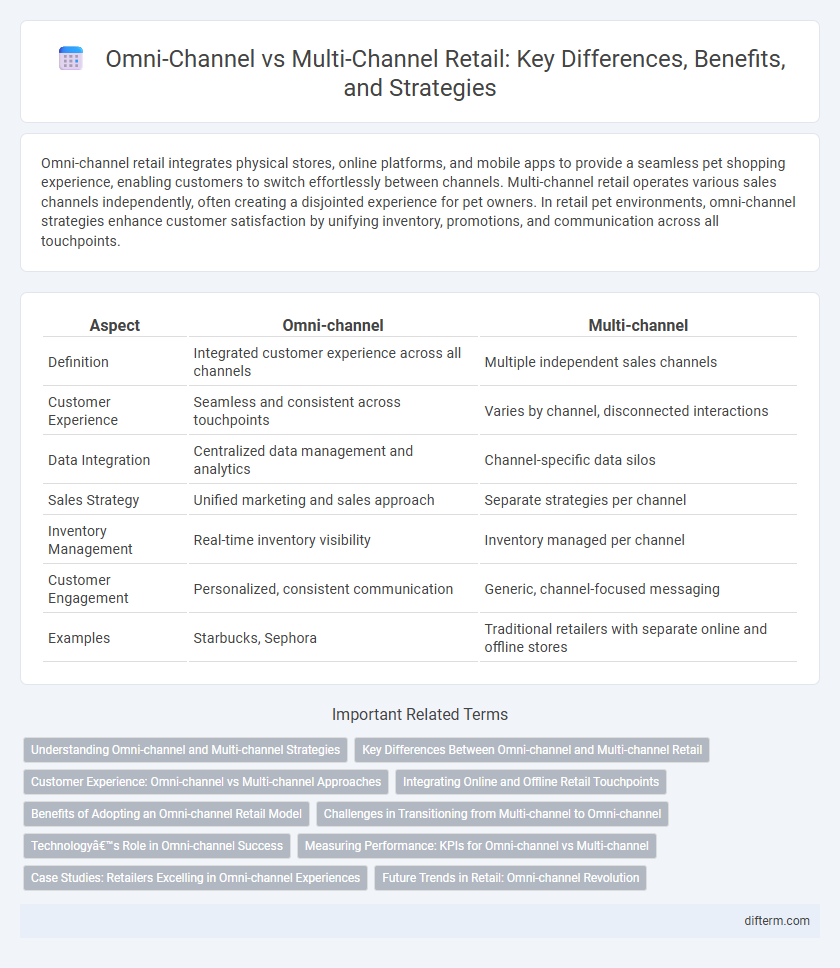Omni-channel retail integrates physical stores, online platforms, and mobile apps to provide a seamless pet shopping experience, enabling customers to switch effortlessly between channels. Multi-channel retail operates various sales channels independently, often creating a disjointed experience for pet owners. In retail pet environments, omni-channel strategies enhance customer satisfaction by unifying inventory, promotions, and communication across all touchpoints.
Table of Comparison
| Aspect | Omni-channel | Multi-channel |
|---|---|---|
| Definition | Integrated customer experience across all channels | Multiple independent sales channels |
| Customer Experience | Seamless and consistent across touchpoints | Varies by channel, disconnected interactions |
| Data Integration | Centralized data management and analytics | Channel-specific data silos |
| Sales Strategy | Unified marketing and sales approach | Separate strategies per channel |
| Inventory Management | Real-time inventory visibility | Inventory managed per channel |
| Customer Engagement | Personalized, consistent communication | Generic, channel-focused messaging |
| Examples | Starbucks, Sephora | Traditional retailers with separate online and offline stores |
Understanding Omni-channel and Multi-channel Strategies
Omni-channel strategies integrate multiple retail channels to deliver a seamless and consistent customer experience across physical stores, online platforms, mobile apps, and social media. Multi-channel approaches involve using several separate channels independently, often lacking unified customer engagement or data sharing. Understanding these distinctions helps retailers optimize customer interactions, improve loyalty, and increase sales by aligning marketing, inventory, and service across all customer touchpoints.
Key Differences Between Omni-channel and Multi-channel Retail
Omni-channel retail integrates various shopping channels to create a seamless and consistent customer experience across online, offline, and mobile platforms, whereas multi-channel retail operates multiple channels independently without unified customer interaction. Omni-channel leverages data centralization to personalize marketing and inventory management, improving customer retention and satisfaction, while multi-channel focuses mainly on expanding customer reach through separate sales channels. The key difference lies in omni-channel's emphasis on a cohesive brand experience and synchronized operations versus multi-channel's parallel, disconnected channel management.
Customer Experience: Omni-channel vs Multi-channel Approaches
Omni-channel retail integrates all customer touchpoints into a seamless experience, ensuring consistent interaction whether online, in-store, or via mobile apps, enhancing customer satisfaction and loyalty. Multi-channel retail operates through separate channels that function independently, often leading to fragmented customer journeys and inconsistent service. Brands leveraging omni-channel strategies report higher customer retention rates and increased sales due to personalized and unified shopping experiences across platforms.
Integrating Online and Offline Retail Touchpoints
Omni-channel retail seamlessly integrates online and offline touchpoints, creating a unified customer experience across websites, physical stores, mobile apps, and social media platforms. Multi-channel retail, by contrast, operates these channels independently, often resulting in fragmented customer journeys and inconsistent messaging. Emphasizing data synchronization and real-time inventory updates, omni-channel strategies drive higher customer engagement and boost sales by ensuring consistent interactions throughout the entire shopping process.
Benefits of Adopting an Omni-channel Retail Model
Adopting an omni-channel retail model enhances customer experience by providing a seamless and consistent interaction across all touchpoints, including physical stores, online platforms, and mobile apps. This integrated approach increases customer loyalty and lifetime value through personalized marketing and unified inventory management. Retailers benefit from improved data insights, enabling precise demand forecasting and efficient supply chain operations.
Challenges in Transitioning from Multi-channel to Omni-channel
Transitioning from multi-channel to omni-channel retail presents significant challenges including data integration across platforms, maintaining consistent customer experiences, and real-time inventory synchronization. Retailers often struggle with legacy systems that inhibit seamless communication between online and offline channels, leading to fragmented customer journeys and operational inefficiencies. Overcoming these obstacles requires investing in advanced technology stacks, unified customer data platforms, and cross-functional team alignment to ensure a fully integrated, seamless shopping experience.
Technology’s Role in Omni-channel Success
Technology is pivotal in omni-channel retail, integrating inventory management, customer data, and sales platforms to create a seamless shopping experience across online and offline channels. Advanced technologies like AI-powered analytics and real-time data synchronization enable personalized marketing and efficient supply chain coordination. Multi-channel approaches often lack this level of integration, resulting in fragmented customer journeys and inconsistent service quality.
Measuring Performance: KPIs for Omni-channel vs Multi-channel
Measuring performance in retail requires distinct KPIs for omni-channel and multi-channel strategies, focusing on customer engagement, channel integration, and sales attribution. Omni-channel KPIs emphasize seamless customer experience metrics such as cross-channel conversion rates, unified customer lifetime value, and consistent brand interaction scores. Multi-channel performance relies on individual channel metrics like channel-specific sales growth, customer acquisition cost per channel, and isolated customer satisfaction ratings.
Case Studies: Retailers Excelling in Omni-channel Experiences
Retailers like Starbucks and Nordstrom showcase exemplary omni-channel strategies by seamlessly integrating online, mobile, and in-store experiences, leading to increased customer engagement and higher lifetime value. Starbucks' mobile app enables order-ahead and loyalty rewards across channels, while Nordstrom's unified inventory system allows customers to shop effortlessly via web, mobile, or physical stores. These case studies highlight how combining data analytics with consistent touchpoints drives superior customer satisfaction and competitive advantage in retail.
Future Trends in Retail: Omni-channel Revolution
The future of retail is shaped by the omni-channel revolution, integrating physical stores, e-commerce, mobile apps, and social media into a seamless customer experience. Advanced AI-driven personalization, real-time inventory management, and unified payment systems are key drivers enabling retailers to offer consistent and convenient shopping journeys across all touchpoints. This strategic shift from multi-channel to omni-channel frameworks enhances customer engagement and boosts lifetime value through synchronized data and service integration.
Omni-channel vs Multi-channel Infographic

 difterm.com
difterm.com